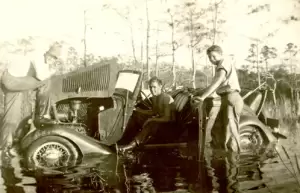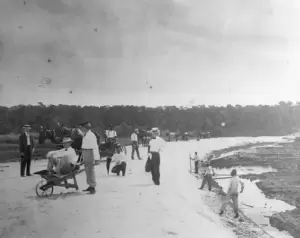Getting Around: Roads

As automobiles became affordable for the growing middle class after World War I, people from all over the U.S. were able to drive to Florida, which helped to create the real estate boom. Both the changes in automobiles and the boom caused a surge in road construction in Palm Beach County throughout the boom era. New roads were added, and existing roads were improved.
By 1915, parts of the Dixie Highway were paved with stone, shells or brick. It was finished in the mid-1920s from the Canadian border to Miami. In Palm Beach County as elsewhere, many sections of the Dixie Highway overlap with US 1, which the federal government designated from Maine to Miami in 1926. This and other numbered U. S. highways are referred to as the Federal Highway, although state and local governments maintain them.

In 1917 Okeechobee Road (now Boulevard) was built as far west as Loxahatchee Groves, fifteen mileswest of West Palm Beach; it was paved as far as Military Trail (FL 809) in 1926.
Military Trail received its first pavement in 1923, from the West Palm Beach Canal. During the 1930s, the Works Progress Administration (WPA) of President Franklin Roosevelt’s “New Deal” helped to rebuild Military Trail from Lake Park Road (now Northlake Boulevard) south to Okeechobee Road, and later to Delray Road. The northern part was a yearlong project done mostly by hand with shovels and wheelbarrows.
In 1925 Jupiter residents approved a bridge to be added over the East Coast Canal at Wilson Road, and six roads to be built or improved, including Indiantown Road and Dixie Highway. In Loxahatchee Lament, Anna Minear wrote that most of Jupiter’s streets were laid out during the boom, but after the bust, “It was kind of desolate, streets and sidewalks in the wilderness.”
State Road A1A opened in 1927 as Atlantic Boulevard, running mostly along the beach on the barrier islands of Palm Beach County; in Palm Beach and Jupiter, the road crosses to the mainland. It was renamed State Road 1, then A1A in 1946 to avoid confusion with US 1.
Despite the addition of many miles of new roads in Palm Beach County, The Works Progress Administration [WPA] Guide to Florida reported in 1939 that in West Palm Beach’s business area, “motorcar congestion has necessitated extensive one-way traffic regulations.”

